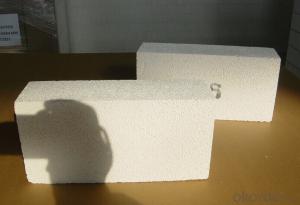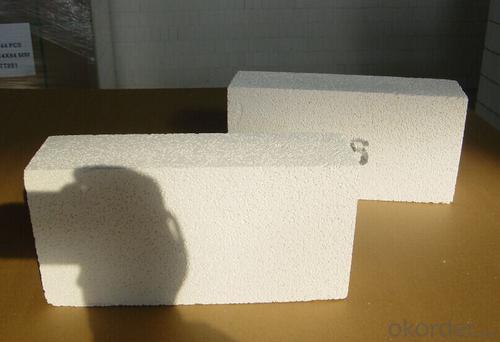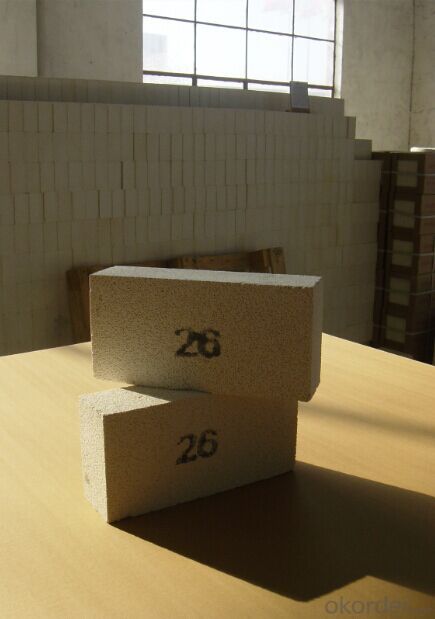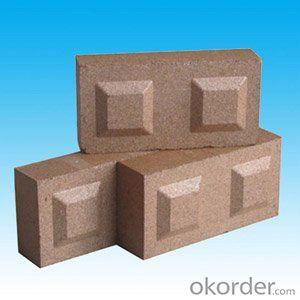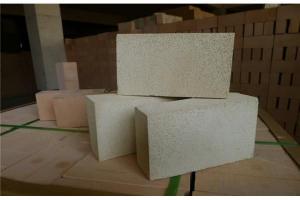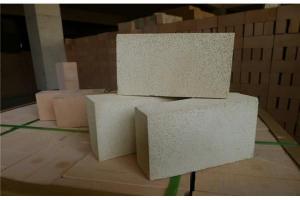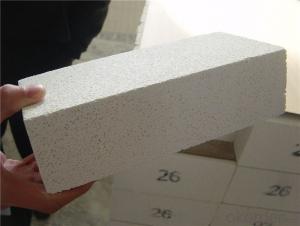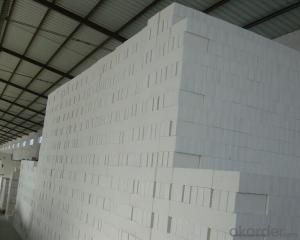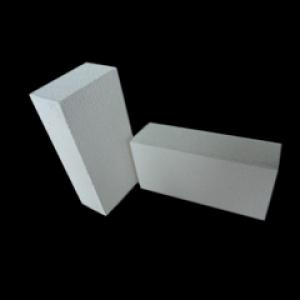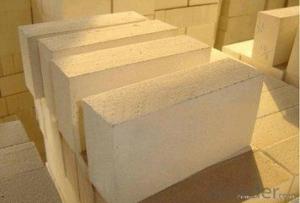Insulation Bricks Or Insulation Fire Brick High Quality 23 26
- Loading Port:
- Shanghai
- Payment Terms:
- TT OR LC
- Min Order Qty:
- 5000 pc
- Supply Capability:
- 50000 pc/month
OKorder Service Pledge
OKorder Financial Service
You Might Also Like
1.Description of Insulation Brick:
CMAX insulating firebricks are classified under temperature between 1100℃ to 1700℃, manufactured from high purity alumina clay..
2.Main features of Insulation Brick:
◆Light weight and low thermal conductivity ◆Low heat storage
◆Low iron and impurities ◆High thermal shock resistance
3. Insulation Brick Images:

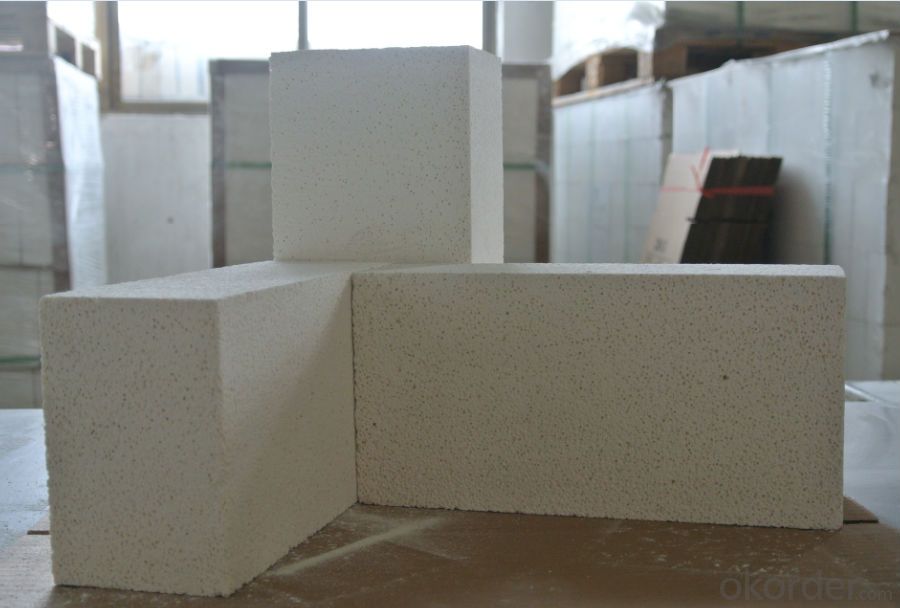
4. Insulation Brick Technical Parameters
Our Insulation Brick contains 20, 23, 25,26, 28, 30, 32. Classification temperature is from 1100℃ to 1760℃. Density is from 0.52g/cm3 to 1.25g/cm3. As we all know, the company type is 23 and 26.
1) For the 23, its density is 0.52g/cm3, but some customer may require 0.8g/cm3, we can also meet your special require. Content of Al2O3 is about 45%.
2) For the 26, its density is 0.8g/cm3, but if you have other special requirement on that, pls also tell us. Content of Al2O3 is about 55%.
Application: CMAX insulating firebricks can be used as a hot face lining directly exposed to the heat or as a backup insulation layer in iron and steel mills, non-ferrous foundries, petrochemical, ceramic, glass. If you need other application picture, please contact with us
5.FAQ
We have organized several common questions for our clients,may help you sincerely:
① How about our Insulation Brick?
A world class manufacturer & supplier of InsulationBrick is one of the large scale professional investment casting production bases in China,consisting of both casting foundry forging and machining factory. Annually more than 8000 tons Precision casting and forging parts are exported to markets in Europe,America and Japan. OEM casting and forging service available according to customer’s requirement.
②How to guarantee the quality of the products?
We have established the international advanced quality management system every link from raw material to final product we have strict quality test; We resolutely put an end to unqualified products flowing into the market. At the same time, we will provide necessary follow-up service assurance.
- Q: The insulation layer destroyed after use of cement paste and tiling
- Attach tiles directly to the insulating layer. But one requirement is to check the insulation process in the balcony of your house. Usually wall - insulation layer - galvanized wire mesh - cement mortar, scraping - paint. If the lack of process fill such as galvanized mesh, remove paint, and tiling. You can use high mark cement or direct adhesive.
- Q: Can insulating fire bricks be used in the construction of pottery extruders?
- Yes, insulating fire bricks can be used in the construction of pottery extruders. These bricks are known for their high heat resistance, low thermal conductivity, and excellent insulating properties, making them suitable for applications where high temperatures are involved, such as pottery extrusion. They can help maintain a consistent temperature within the extruder, ensuring optimal working conditions for the clay and improving overall efficiency.
- Q: Are insulating fire bricks resistant to erosion?
- Yes, insulating fire bricks are resistant to erosion.
- Q: Can insulating fire bricks be used for insulation in power plants?
- Insulating fire bricks have proven themselves to be effective for insulation purposes in power plants. These bricks are specifically designed to possess exceptional thermal insulation properties, making them highly suitable for applications involving high temperatures. They can endure extreme temperatures and effectively insulate power plant operations, thus preventing heat loss and enhancing energy efficiency. In power plants, insulating fire bricks find extensive usage in various areas, including furnaces, boilers, kilns, and chimneys. They can be utilized to line the walls, floors, and roofs of these structures, aiming to minimize heat transfer and maintain optimal temperatures within the equipment. The utilization of insulating fire bricks in power plants offers numerous benefits. These bricks aid in reducing heat loss, enhancing combustion efficiency, and alleviating thermal stress on the equipment. They create a barrier against heat transfer, thereby conserving energy and minimizing operational expenses. Moreover, their insulation properties contribute to a safer working environment for power plant personnel. Nevertheless, it is important to exercise caution when selecting insulating fire bricks for power plant insulation. The specific requirements and conditions of the power plant should be carefully considered. Factors such as operating temperature, exposure to chemicals, and mechanical stress should be taken into account to ensure that the bricks are capable of withstanding harsh conditions and delivering long-lasting insulation performance.
- Q: Insulation brick should pay attention to external walls?
- Construction at room temperature, 24h after spraying water conservation, water spraying should not be too much, not flow. Unsuitable for winter construction. According to the national standard, seven consecutive days and nights, the average temperature is less than 5 degrees, may not carry on the external wall insulation, brick construction.
- Q: Can insulating fire bricks be used as a thermal barrier?
- Yes, insulating fire bricks can be used as a thermal barrier. Insulating fire bricks are specifically designed to have low thermal conductivity, meaning they are able to effectively reduce heat transfer. This makes them an excellent choice for thermal insulation applications. They are commonly used in industries where high temperatures are involved, such as in furnaces, kilns, and other heat-intensive processes. Insulating fire bricks can help to minimize heat loss, maintain consistent temperatures, and improve energy efficiency. Additionally, their lightweight nature makes them easy to handle and install, further enhancing their suitability as a thermal barrier.
- Q: Can insulating fire bricks be used as a backup insulation in refractory linings?
- Yes, insulating fire bricks can be used as a backup insulation in refractory linings. They are designed to withstand high temperatures and provide excellent thermal insulation properties, making them suitable for this purpose.
- Q: Are insulating fire bricks suitable for use in kilns and furnaces?
- Insulating fire bricks are a suitable choice for kilns and furnaces, offering excellent thermal insulation that is ideal for applications requiring high temperatures. These bricks are specifically designed to provide outstanding thermal insulation, making them perfect for kilns and furnaces. With their low thermal conductivity, they effectively minimize heat loss, thereby enhancing energy efficiency. Furthermore, their lightweight and durable nature allows for easy installation and long-lasting performance in high-temperature environments. Not only are they resistant to thermal shock, but they also withstand rapid temperature changes, making them a reliable option for kilns and furnaces. Overall, insulating fire bricks are an exceptional choice for insulation and the maintenance of high temperatures in kilns and furnaces.
- Q: Can insulating fire bricks be used in glass furnaces?
- Yes, insulating fire bricks can be used in glass furnaces. They are commonly used to line the walls and roofs of glass furnaces to reduce heat loss, improve energy efficiency, and provide thermal insulation.
- Q: Can insulating fire bricks be used for insulation in heat treatment furnaces?
- Indeed, insulation in heat treatment furnaces can be achieved through the utilization of insulating fire bricks. These bricks are specially engineered to endure extreme temperatures and offer exceptional thermal insulation properties. With their low thermal conductivity, they effectively trap heat within the furnace. Moreover, their lightweight composition facilitates effortless handling and installation. Insulating fire bricks find widespread application in diverse heat treatment procedures, including annealing, tempering, and hardening, guaranteeing utmost heat retention and energy efficiency within the furnace.
Send your message to us
Insulation Bricks Or Insulation Fire Brick High Quality 23 26
- Loading Port:
- Shanghai
- Payment Terms:
- TT OR LC
- Min Order Qty:
- 5000 pc
- Supply Capability:
- 50000 pc/month
OKorder Service Pledge
OKorder Financial Service
Similar products
Hot products
Hot Searches
Related keywords
